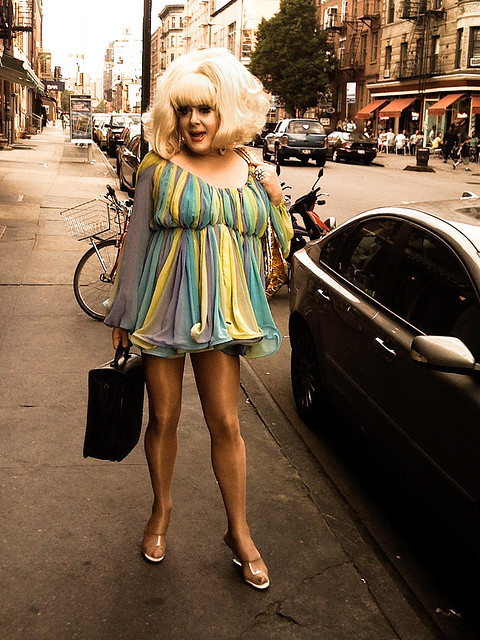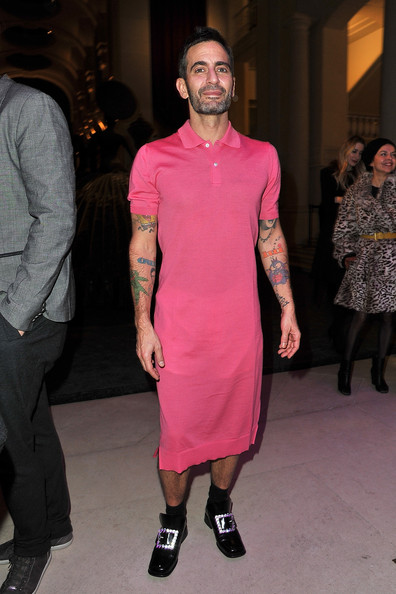Ask Anna: Why Don't Men Wear Dresses and Skirts?



 Pants and skirts have happily coexisted for much of human history. Most ancient cultures had some form of skirt for both men and women, but pants also have existed since at least the 6th century BC. Hose became a versatile staple in men’s fashion through the 17th century, easily worn with any number of skirts, dresses, or elongated shirts. Later, the style of the separated hose had developed into pantaloons and stockings in Western Culture. The modern, full length pant, while worn earlier by low-class farmers, became adopted as a socially accepted style in France during the French Revolution (1787-99). This was due to the new government’s attempt to disassociate themselves from the previous rule. The style became adopted throughout Europe, as robe-a-la-francaise was the most accepted style of dress. Additionally, the industrial revolution naturally necessitated pants, as they offered more protection to the body.
Pants and skirts have happily coexisted for much of human history. Most ancient cultures had some form of skirt for both men and women, but pants also have existed since at least the 6th century BC. Hose became a versatile staple in men’s fashion through the 17th century, easily worn with any number of skirts, dresses, or elongated shirts. Later, the style of the separated hose had developed into pantaloons and stockings in Western Culture. The modern, full length pant, while worn earlier by low-class farmers, became adopted as a socially accepted style in France during the French Revolution (1787-99). This was due to the new government’s attempt to disassociate themselves from the previous rule. The style became adopted throughout Europe, as robe-a-la-francaise was the most accepted style of dress. Additionally, the industrial revolution naturally necessitated pants, as they offered more protection to the body.
 Men’s fixation on pants is a bit Western-centric, however, even today. In warmer climates, many men still wear skirts or draped garments in one form or another today. Some examples include the unstitched dhoti in India, printed and fairly unisex sarongs in Southeast Asia and the Pacific, and the colorful Eastern African garment, Kanga. As we’ve touched on in our article about the suit, fashion is just a symptom of larger cultural norms and changes. The gendering of clothing is part coincidence and part history. As men grew to incorporate pants into their wardrobe, women were restricted from doing the same because of norms of “modesty”; pants hugged the body and revealed the woman’s shape more, and so women were relegated to long skirts, even as men became more versatile in their wardrobe. This in turn made loose garments like dresses and skirts take on a feminine association, and today, most men avoid these garments for nothing more than that reason – a fear of femininity in combination with a recognition of the social norm that they should dress in ways that uphold their masculine identities. Look at the only non-taboo form of skirt in the West today: the kilt. Though it’s got the same anatomy of any other skirt that a woman might wear, nobody bats an eye at it because it’s read as a masculine garment that is worn to honor someone’s (Scottish) heritage.
Men’s fixation on pants is a bit Western-centric, however, even today. In warmer climates, many men still wear skirts or draped garments in one form or another today. Some examples include the unstitched dhoti in India, printed and fairly unisex sarongs in Southeast Asia and the Pacific, and the colorful Eastern African garment, Kanga. As we’ve touched on in our article about the suit, fashion is just a symptom of larger cultural norms and changes. The gendering of clothing is part coincidence and part history. As men grew to incorporate pants into their wardrobe, women were restricted from doing the same because of norms of “modesty”; pants hugged the body and revealed the woman’s shape more, and so women were relegated to long skirts, even as men became more versatile in their wardrobe. This in turn made loose garments like dresses and skirts take on a feminine association, and today, most men avoid these garments for nothing more than that reason – a fear of femininity in combination with a recognition of the social norm that they should dress in ways that uphold their masculine identities. Look at the only non-taboo form of skirt in the West today: the kilt. Though it’s got the same anatomy of any other skirt that a woman might wear, nobody bats an eye at it because it’s read as a masculine garment that is worn to honor someone’s (Scottish) heritage.
 Like any taboo in modern days, however, there are men who flirt with the skirt because it is oftentimes controversial or subversive for men to willingly do so. Drag queens and similar types of gender-bending performers, of course know how to rock dresses, skirts, pants, bodysuits, and everything in between, specifically embodying and exploring forms of gender play and fluidity. Even people (such as Marc Jacobs in a dress, shown above) who buck the system seemingly without rhyme or reason, wear these garments specifically because gender and its assignment to things that populate our everyday routines (like clothing) is such a hotbed of controversy. The fact that a man wearing a skirt is even seen as strange, offensive, wacky, or rebellious is proof in itself of how pervasive our cultural norms are and how strongly we are willing to uphold them.
Like any taboo in modern days, however, there are men who flirt with the skirt because it is oftentimes controversial or subversive for men to willingly do so. Drag queens and similar types of gender-bending performers, of course know how to rock dresses, skirts, pants, bodysuits, and everything in between, specifically embodying and exploring forms of gender play and fluidity. Even people (such as Marc Jacobs in a dress, shown above) who buck the system seemingly without rhyme or reason, wear these garments specifically because gender and its assignment to things that populate our everyday routines (like clothing) is such a hotbed of controversy. The fact that a man wearing a skirt is even seen as strange, offensive, wacky, or rebellious is proof in itself of how pervasive our cultural norms are and how strongly we are willing to uphold them.